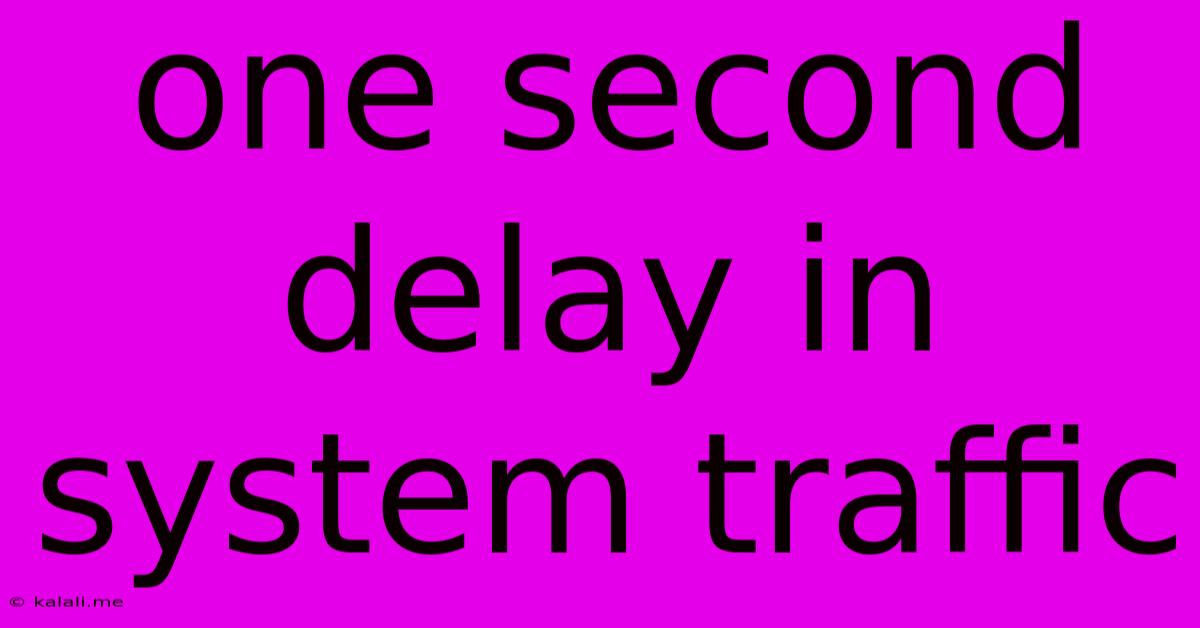One Second Delay In System Traffic
Kalali
May 23, 2025 · 3 min read

Table of Contents
One-Second Delay in System Traffic: A Critical Look at Causes and Solutions
A one-second delay might seem insignificant, a mere blink of an eye. But in the high-speed world of online systems and applications, even a single second of latency can significantly impact user experience, conversion rates, and overall system performance. This article delves into the causes of a one-second delay in system traffic and explores effective solutions to mitigate this performance bottleneck. Understanding this issue is crucial for maintaining a smooth, responsive, and successful online presence.
What Causes a One-Second Delay?
Pinpointing the source of a one-second delay requires a methodical approach. The culprit isn't always immediately obvious and often involves a combination of factors. Here are some common causes:
Network Issues:
- Network Congestion: High traffic volume on your network infrastructure can lead to delays as packets compete for bandwidth. This is particularly noticeable during peak hours or with sudden traffic spikes.
- Slow Internet Connection: A slow internet connection for either the user or the server can contribute significantly to latency. This can stem from various factors, including ISP issues, geographical limitations, or faulty hardware.
- DNS Resolution Problems: Slow or inefficient DNS resolution can add substantial delays as the system takes longer to translate domain names into IP addresses.
- Routing Problems: Inefficient or overloaded routers can create delays as data packets are routed across the network.
Server-Side Issues:
- Database Bottlenecks: Slow database queries, inefficient database design, or insufficient database resources can significantly impact response times. This is common when dealing with large datasets or complex queries.
- Application Code Inefficiencies: Poorly written or inefficient application code can introduce significant delays. This can include inefficient algorithms, excessive database calls, or lack of optimization.
- Server Hardware Limitations: Outdated or underpowered servers may struggle to handle the traffic load, resulting in noticeable delays. Insufficient RAM, slow processors, or inadequate storage can be the culprits.
- Resource Exhaustion: High CPU usage, memory leaks, or insufficient disk space can throttle the server's performance and contribute to delays.
Client-Side Issues:
- Browser Caching Issues: While caching is generally beneficial, improperly configured or corrupted browser caches can lead to unexpected delays.
- Client-Side Scripting Problems: Inefficiently written JavaScript code or excessive use of client-side resources can impact response times.
- Device Limitations: Older or underpowered devices may struggle to process information efficiently, resulting in noticeable delays.
Strategies for Resolving One-Second Delays:
Addressing a one-second delay requires a systematic approach. Here's a breakdown of strategies, focusing on both immediate solutions and long-term improvements:
Immediate Actions:
- Check Server Status: Monitor server resources (CPU, memory, disk I/O) to identify potential bottlenecks.
- Review Recent Changes: If the delay is recent, review any recent code deployments, configuration changes, or traffic spikes. Rollback if necessary.
- Restart Services: Restarting relevant services (web servers, databases) can sometimes resolve temporary issues.
Long-Term Solutions:
- Optimize Database Queries: Analyze and optimize database queries to improve efficiency. Consider indexing, query caching, and database tuning.
- Optimize Application Code: Refactor inefficient code, reduce database calls, and implement caching strategies. Profiling tools can help identify performance hotspots.
- Upgrade Server Hardware: Consider upgrading to more powerful servers with greater processing power, memory, and storage capacity.
- Implement Load Balancing: Distribute traffic across multiple servers to prevent overload on any single server.
- Improve Network Infrastructure: Invest in a robust and high-bandwidth network infrastructure to handle traffic peaks.
- Implement Content Delivery Network (CDN): A CDN can significantly reduce latency by serving content from servers closer to users geographically.
- Regular Monitoring and Alerting: Implement robust monitoring tools to proactively identify and address potential performance issues.
Conclusion:
A seemingly minor one-second delay can significantly impact user experience and business success. By understanding the potential causes and implementing the appropriate solutions, you can ensure your online systems remain responsive, efficient, and deliver a positive user experience. Remember that a proactive approach to performance monitoring and optimization is crucial for long-term stability and success.
Latest Posts
Latest Posts
-
Pokemon Mystery Dungeon Red Rescue Team Codes
Jul 05, 2025
-
How Much Is 25 20 Dollar Bills
Jul 05, 2025
-
How Many Apples In 3 Lb Bag
Jul 05, 2025
-
What Is Half A Quarter Of 400
Jul 05, 2025
-
How Do You Make A Vegetable Necklace
Jul 05, 2025
Related Post
Thank you for visiting our website which covers about One Second Delay In System Traffic . We hope the information provided has been useful to you. Feel free to contact us if you have any questions or need further assistance. See you next time and don't miss to bookmark.